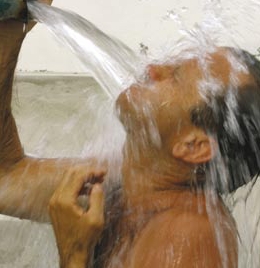Paying the price for clean water
(November 1, 2005)
Utilities receive assistance from the UNDP/GEF Danube Regional Project to set tariffs and charges that reflect the real costs of providing services to customers which can be invested into pollution control systems to reduce nutrient and toxic pollution in the Danube River Basin.
The city of Karlovac, population 60,000, dumps its wastewater directly into local rivers that lead to the Danube - more than any other city in Croatia. To build an advanced wastewater treatment plant, the city sought international .nancing from the Eu-ropean Bank for Reconstruction and Development (EBRD) and European Commission (EC).
Tools to understand water pricing. To prepare the EBRD proposal, Karlovac received technical assistance from the UNDP/GEF Danube Regional Project (DRP). "We learned a lot about how to use tariffs and charges and how they can be used to pay back the loan," says Kresimir Veble, an employee for 27 years of the water supply utility owned by the City of Karlovac.
Water pricing in Karlovac has traditionally included costs for supplying water and charges for water use and water protection. The city has been fortunate with good local sources of water and a strong industrial base that together drove prices down. "Now it must include the price of the new treatment plant," says Veble.
With expert assistance from the DRP's Tariffs and Effluent Charges Project, workers at the Karlovac utility were taught how to use a tool called ASTEC to test financial implications of applying different reforms to tariffs and charges. For Karlovac, an optimal solution was to raise water tariffs by 45% for consumers. "We are, however, very concerned about families with low incomes," he says, "and have prepared for avoiding social problems."

Municipal water and wastewater utilities are not only expected to maintain current service levels, they are expected to meet new and expensive demands to upgrade wastewater systems and wastewater treatment.
-
Tarifs encourage customers to reduce water use and wastewater discharge, and effluent charges encourage utilities to increase their pollution reduction activities.
Credit: Fallander /CCHBC
Bringing costs in line. "Price increases cannot happen overnight," says DRP expert Andras Kis. "They will gradually happen over time along with EBRD assistance for a communications campaign."
Before committing to long-term investments, Kis advises municipalities to first get current conditions in order. "Many utilities don't even know their true costs, let alone how to reduce them," he says. "Things like losing water through leaky pipes, employing an oversized workforce or wasting money on unnecessary expenditures. The first step is to straighten this out." Kis adds that Karlovac's loan will be accompanied by EBRD technical assistance to improve current operations.
The DRP Tariffs Project started by assessing current practices in nine countries followed by recommendations for reforms to reduce pollution without jeopardising services or unreasonably burdening customers. Possible reforms include setting tariffs that reflect the real costs of providing services to different customers, introducing advanced water metering systems, and rewarding utilities that are progressive in reducing local pollution. The project contributes to the overall DRP goal of reducing nutrient and toxic pollution in the Danube River Basin. For more information, please visit: www.undp-drp.org.
This article was written for the Danube Watch by Paul Csagoly, who is a communications consultant with the UNDP/GEF Danube Regional Project through which he assists by writing stories about people and nature in the Danube River Basin.






